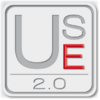Usability Evaluation (Us.E.)
Usability Evaluation (Us.E.) is a multidimensional questionnaire aimed at assessing website usability. The questionnaire has been developed by Francesco Di Nocera, Fabio Ferlazzo e Paolo Renzi (Department of Psychology, Sapienza University of Rome, Italy) in 1997, although the questionnaire itself was publicly presented only in 1999.[1] Its early edition (Us.E 1.0) was a 70-item questionnaire, whereas its final form (Us.E. 2.0[2]) is a 19-item questionnaire subdivided in three subscales representing the cognitive framework users would adopt for evaluating the quality of their interaction with the interface:
- Mental Handling: measuring the interaction with the structure of the website. Low scores in this scale would suggest the need to make changes to information architecture or page layout.
- Satisfaction: measuring the perceived utility of the website. Low scores in this scale may indicate that the website does not meet users' needs either because the users are not those expected by who created the website or because contents / services are not those expected by the users.
- Attractiveness: measuring the interaction with the aesthetic features of the website. Low scores in this scale would suggest the need for a re-styling.
Us.E. 2.0 allows fast assessment of web site usability identifying critical issues that could be eventually addressed by re-design. Users are required to answer to all items along a 5-point Likert scale (ranging from "strongly agree" to "strongly disagree"). In order to obtain stable usability estimates a minimum of 30 respondents are required.[3]
Conditions of use
Us.E was born as a research tool[4][5][6] and it is freely available to the scientific and professional community (CC BY-ND license). The questionnaire is available in Italian and English.
References
- ↑ Di Nocera, F., Ferlazzo, & Renzi, P. (1999). Us.E. 1.0: costruzione e validazione di uno strumento in lingua italiana per valutare l'usabilità dei siti internet. In M.F. Costabile e F.Paternò (a cura di). Atti di HCITALY '99: Giornata italiana su Human-Computer Interaction. Rapporto CNUCE-B4-1999-003.
- ↑ Di Nocera, F. (2013). Usability Evaluation 2.0: Una descrizione (s)oggettiva dell'usabilità. Roma: Ergoproject.
- ↑ Di Nocera, F., Coletta, S., Ferlazzo, F., & Renzi, P. (2009). Numerosità del campione e stabilità della stima di usabilità ottenuta mediante valutazioni soggettive. Giornale Italiano di Psicologia, 3, 695-704.
- ↑ Di Nocera, F., Ferlazzo, F., Renzi, P. (2003). L’usabilità a quattro dimensioni. Ricerche di Psicologia, 26, 83-104.
- ↑ Di Nocera, F., Terenzi, M., & Ferlazzo, F. (2007). Misurare l’Information Handling: Un Contributo Sperimentale sulla Sensibilità della Scala “Maneggevolezza” di Us.E. 1.0. Giornale Italiano di Psicologia, 24(1), 223-234
- ↑ Terenzi, M., Di Nocera, F., Ferlazzo, F. (2006). Firmitas, Utilitas, Venustas: assessing the validity of the Usability Evaluation Questionnaire. In: De Waard D, Brookhuis Ka, Toffetti A. (Eds), Developments in Human Factors in Transportation, Design, and Evaluation, Maastricht: Shaker Publishing.
Similar tools
System Usability Scale


